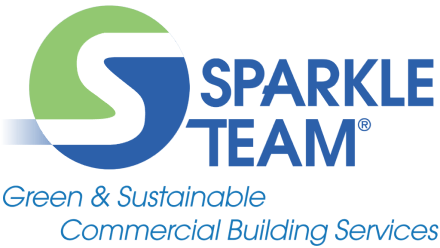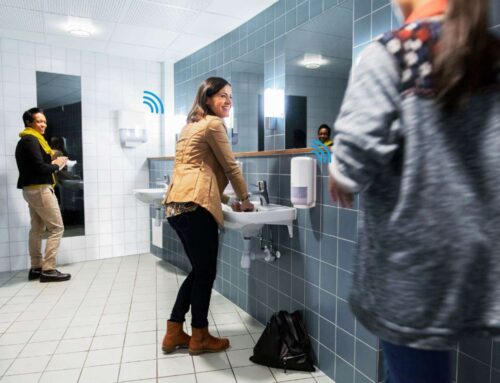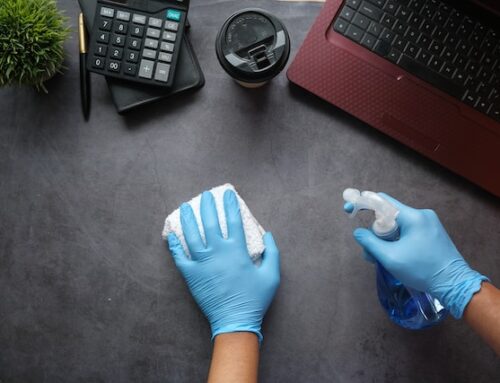Top Germiest Places in the Office
What to clean and what to avoid to prevent the spread of COVID-19

With the increased availability of COVID-19 vaccinations nationwide, more businesses are planning and preparing their teams to return to the office full time. However, sharing spaces again brings greater risk of infection. Current research suggests COVID-19 spreads primarily from person to person, whether through respiratory droplets or airborne transmission. Touching surfaces contaminated with the virus also provides a secondary risk of exposure.
When mitigating these risks, enclosed areas like office buildings pose a perfect storm of challenges. Facilities can be made more resilient with adjustments that improve ventilation (such as opening windows and doors, adding portable fans, and switching your HVAC-fan from “auto” to “on,” so your system is constantly circulating air). The building’s structural set-up may limit how you can adopt these methods. In addition, disinfecting high-risk areas can further help decrease the overall vulnerabilities of the facility.
With this in mind, the most effective form of protection focuses on disinfecting “high-touch points” — shared objects and surfaces we interact with every day. To prevent potential infection, we have adapted our cleaning and disinfection process to respond to these pandemic-related challenges. But where are these points of high contact in the office that require a higher standard of disinfection? And can they be reconfigured at all to reduce contact? We explore the areas that require greater attention — and some may surprise you.
Handles
 Door handles and doorknobs are the most obvious culprits for spreading germs, as they provide access in and out of areas. Note, however, that the average office is filled with other handles in high-traffic areas. With this in mind, at SparkleTeam we also focus our targeted COVID-19 disinfection protocols on areas like hand railings. This is also true for restrooms, taking special care with handles for toilets, faucets and soap dispensers. To reduce these potential points of contact, some objects can be replaced with automatic alternatives like no-touch trash cans and touchless paper towel dispensers.
Door handles and doorknobs are the most obvious culprits for spreading germs, as they provide access in and out of areas. Note, however, that the average office is filled with other handles in high-traffic areas. With this in mind, at SparkleTeam we also focus our targeted COVID-19 disinfection protocols on areas like hand railings. This is also true for restrooms, taking special care with handles for toilets, faucets and soap dispensers. To reduce these potential points of contact, some objects can be replaced with automatic alternatives like no-touch trash cans and touchless paper towel dispensers.
Buttons
 In our modern tech-driven spaces, nothing can get started without the press of a button — lots of buttons, in fact. This includes buttons that are part of an office’s daily functions, such as elevator buttons, light switches and large equipment like copy machines. These devices are also key focal areas as part of our disinfection procedure in response to COVID-19. As an additional safety measure, individuals can be assigned to their own devices (like computer keyboards and telephones), which would help limit shared surface contact.
In our modern tech-driven spaces, nothing can get started without the press of a button — lots of buttons, in fact. This includes buttons that are part of an office’s daily functions, such as elevator buttons, light switches and large equipment like copy machines. These devices are also key focal areas as part of our disinfection procedure in response to COVID-19. As an additional safety measure, individuals can be assigned to their own devices (like computer keyboards and telephones), which would help limit shared surface contact.
Shared items
Building camaraderie in the office, it’s natural for employees to share everyday items, from pens to coffee cups. Or they gather to chat and collaborate over the office’s water cooler or coffee pot. Sharing these objects, however, are not ideal when reconfiguring the office for social distancing. With this in mind, consider removing these items and replacing them with individual options that people can keep for themselves — like single use cups and water bottles.
The loss of these iconic water cooler chats poignantly expose how much has changed since the COVID-19 outbreak. We look forward to the return of these precious moments that only come when we work together. However, we also take comfort in knowing that only through collaboration, we can assist in keeping your facility safe for the future to come.





